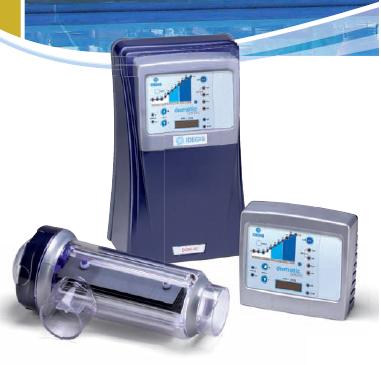Types of Chlorine Generators
There are two types in use today on residential pools. The first one is a brine unit. This unit does not require the pool to have salt added to it. A tank or chamber at the pool equipment area has a predetermined amount of salt in it. Through electrolysis, chlorine is produced and immediately injected into the pool circulation system. These units are messy and produce by-products that are not simple to dispose of. These are the less common of the two types.
The recommended unit is the type requiring that salt be added to the swimming pool. There are two types of these units. One has the chlorine-producing cell and the electronics installed at the equipment while the other has the cell installed in the deck near the pool with the electronics usually located at the equipment. The deck unit works on the principle of convection. It makes chlorine even if the pump is off while the other more common unit makes chlorine as water is passed through the cell with the circulation system (pool pump on.) In both cases the cell must remain free of mineral deposits or it will not work properly. Of these two units, the inline unit with 24-hour circulation is the preferred choice.
What About Polarity?
There are non-reverse polarity units and reverse polarity units. A reverse polarity unit reverses the electron flow through the cell causing mineral deposits to flake off. In some instances the now larger particles will get caught in the filtration system. So the claim that the units help keep calcium scum off the tile is partially correct. These cells do not require as much cleaning. (Don’t believe a claim that a unit doesn’t ever need to be cleaned.) A reverse polarity unit will cost nominally more than a non-reverse unit.
Bottom Line
Chlorine generators can help fight against waterline scum build-up. They create a better, healthier swimming experience for most people. It isn’t necessary to handle or buy chlorine, and, if the unit is functioning correctly, chlorine residual will always be present in the pool, eliminating algae. This makes it nearly impossible to get burning red eyes from chloramines, which is usually the culprit. Even with a chlorine generator, you still must maintain your pool. You still must maintain correct water balance, and you must maintain the unit itself. The best pool will have 24/7 circulation, correct hydraulic design with an in-floor cleaning system for bottom up cleaning and circulation, a quality ozone system, and a chlorine generator for sanitizer residual. You can expect to pay at least $1,000 and up to several thousand dollars, for a quality chlorine generator unit.
DISCLAIMER: If you do not maintain a chlorine generator or maintain your pool chemistry you can destroy your pool’s interior finish, decking and pool equipment. Salt-water pools are great but they need care.
You now have the recipe for a low maintenance pool. Enjoy, and swim safe!



